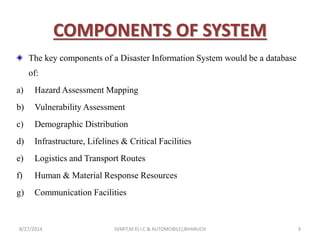Information managment System for Disasters.
- 1. PRESENTATION ON INFORMATIONMANAGEMENT SYSTEM FOR DISASTER MANAGEMENT By: P.D Solanki & Jignesh soni Guided by: Prof. Nayan Soni 8/27/2014 SVMIT,M.E( I.C & AUTOMOBILE),BHARUCH 1
- 2. INTRODUCTION • The communication of accurate, timely, and useful information and instructions to the public is necessary throughout a disaster, not only during the early-warning period. • It is essential that a disaster preparedness capability continually collects and analyses information for its own use, so that it can make sure that humanitarian needs are met and can learn from its experiences. 8/27/2014 SVMIT,M.E( I.C & AUTOMOBILE),BHARUCH 2
- 3. PUBLIC INFORMATION MANAGEMENT Information must reach not only the people at risk but also the public at large. During and immediately after a hazard event there will likely be a high demand for updates and information by those indirectly affected by the disaster event. 8/27/2014 SVMIT,M.E( I.C & AUTOMOBILE),BHARUCH 3
- 4. OBJECTIVE OF INFORMATION MANAGEMENT Systems should be designed and tested in advance in which field staff provide clear information on key issues such as the type and quantities of assistance provided, the most vulnerable locations, key problems encountered or gaps in assistance. 8/27/2014 SVMIT,M.E( I.C & AUTOMOBILE),BHARUCH 4
- 5. PURPOSE OF THE SYSTEM Responsibility for the communication of public information during an emergency should be assigned to a specific department or team. Procedures should be established in advance for securing approval by the appropriate authority regarding which information is released through which channels. 8/27/2014 SVMIT,M.E( I.C & AUTOMOBILE),BHARUCH 5
- 6. INFORMATION MANAGEMENT SYSTEM IN INDIA The “official alert” system for a storm or hurricane entails the coordination between management, the National Emergency Management Organization (NEMO). National Meteorological Service (NMS). The emergency coordinator will therefore activate the required hurricane plan. 8/27/2014 SVMIT,M.E( I.C & AUTOMOBILE),BHARUCH 6
- 7. OFFICAL ALERT EXAMPLE The proposed project will follow the official alert and hurricane categories profile put in place by NEMO. Such categories along with the wind speeds are illustrated in the following: 8/27/2014 SVMIT,M.E( I.C & AUTOMOBILE),BHARUCH 7
- 8. CONTI…. • False Caye will adopt the official Warning Flag System as follows: 8/27/2014 SVMIT,M.E( I.C & AUTOMOBILE),BHARUCH 8
- 9. COMPONENTS OF SYSTEM The key components of a Disaster Information System would be a database of: a) Hazard Assessment Mapping b) Vulnerability Assessment c) Demographic Distribution d) Infrastructure, Lifelines & Critical Facilities e) Logistics and Transport Routes f) Human & Material Response Resources g) Communication Facilities 8/27/2014 SVMIT,M.E( I.C & AUTOMOBILE),BHARUCH 9
- 10. 8/27/2014 SVMIT,M.E( I.C & AUTOMOBILE),BHARUCH 10









